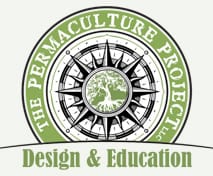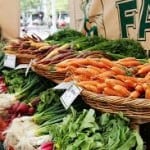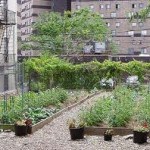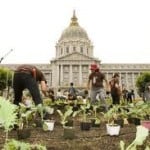Imagine an urban or suburban landscape where every niche in the landscape is filled with a diverse and healthy mix of flowers, fruits, herbs, vegetables, where paths lead one to the next scent, the next fresh and delectable, juicy apple or pear or persimmon, where one can harvest a tomato right off the vine and bite into it on the spot. Imagine a “food forest”, or for that matter, a whole city of food forests, places of gathering, where people harvest nutrient rich foods “at their doorstep”.
There are many empty lots, former building sites, alleyways, parkways along street corridors, roofs, back and front yards, that are ideal for planting, places where we can, as human beings, produce high yields for our sustenance. And in these places we can reestablish some semblance of the pristine wild places that were here, intact for millennia, before us. Nestled into these plant matrices, our buildings and homes are a few steps from tonight’s salad or stir-fry. We are enmeshed in an effort to “relocalize”, to bring the production of fresh food back into cities and towns.
Now imagine the city as a garden city, teeming with the beauty and scent of many flowers and a potential selection of foods that is unlimited, foods that we choose to plant, foods that we carry a short distance to our kitchen, prepare, and sit down with the family to a good night’s meal. There is no car going to the supermarket, no fuel being burned. We walk to the harvest, we are surrounded by health giving plants, we meet others along the way and we talk, exchange ideas, find out from one another what fruit is coming ripe around the next bend, what herb can used in what dish and how we might prepare it.
Imagine cities all over the world feeding a large majority of their population with food grown right at the doorstep. Imagine the urban gardening movement in America taking off in the next few years. It is incredible what can be grown on a postage stamp size plot! The nutritional health of people in urban environments is tantamount to health: socially, politically, economically.
And finally, imagine the ills of the “food desert” eliminated, where we grow healthy produce within city limits and supply the nutritional needs of the urban population, people gardening together, evolving into tight knit communities.
When people garden they benefit from the healthy physical practice of gardening. When people grow their food close to home it eliminates all the supply line issues of the corporate food scene and also the addictive use of fossil fuels for not only transport, but conventional farm practices: synthetic fertilizers, huge tractors and combines. When people gather to garden all the world’s pressures and constraints go by the wayside and we breathe easily, and eat from the fruits of our labors.



